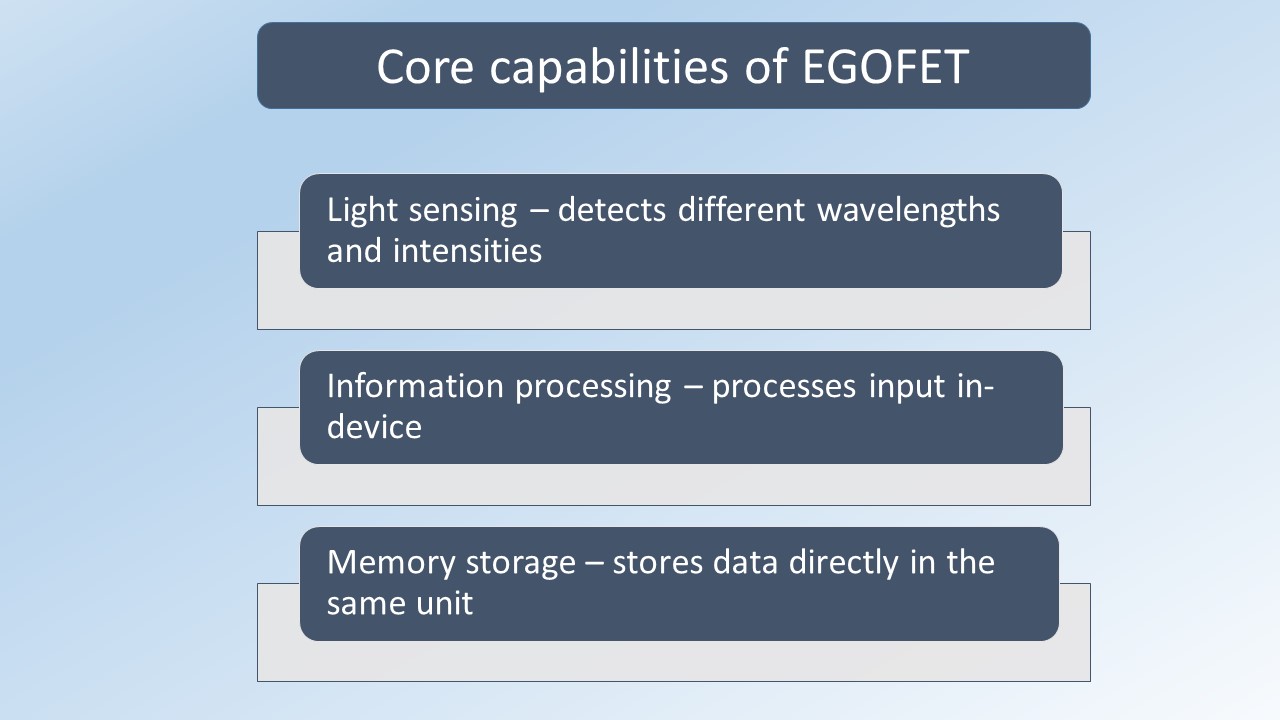Engineers from Glasgow, São Paulo State, and Hong Kong Metropolitan University have developed a low-power system that uses organic, biodegradable, and recyclable materials to detect and store color data.

A recently developed, energy-efficient artificial vision system, designed using brain-like computing principles and incorporating honey-based materials, may offer a more sustainable approach to electronic component design.
Engineers from the University of Glasgow, in collaboration with researchers from São Paulo State University (UNESP) and Hong Kong Metropolitan University, have developed a system that uses organic, biodegradable and recyclable materials to detect and retain color data while operating with minimal power consumption.
The team’s system, called an Electrolyte-Gated Organic Field-Effect Transistor (EGOFET), integrates three core functions —light sensing, information processing, and memory storage —into a single unit designed to emulate aspects of visual perception. It also retains data without power, a characteristic known as non-volatility.
The system may be suited for applications requiring rapid visual information is required, such as autonomous aerial vehicles or automated surveillance systems.
The team’s EGOFET demonstrates specific advantages over earlier artificial vision systems based on silicon CMOS sensors, which tend to be computationally and energy intensive.
Theodoros Serghiou of the University of Glasgow’s James Watt School of Engineering led the development of the EGOFET. He said: “In conventional computing, there’s an inherent latency from having to fetch and transfer data in CMOS-based systems due to the physical separation between the processing and memory units.
“Our new memory-based device, however, performs these functions simultaneously in-memory, similar to how synapses in the human brain work, helping to overcome the bottlenecks of conventional systems.
“Our device’s ultra-low power consumption and sustainable materials could pave the way for eco-friendly, scalable artificial vision systems in the years to come.”
In a paper published in Advanced Functional Materials, the team reports the development of a prototype EGOFET on a glass substrate with gold electrodes, a photosensitive organic perylene layer and honey serving as the electrolyte.
The system functions as a photodetector, generating current signals that vary with different wavelengths and light intensities., These signals enable the encoding of memory states that are retained even when the system is powered off.
The EGOFET demonstrates high energy efficiency, requiring just 2.4 picojoules per spiking event, – placing it among the more efficient devices in its class. In contrast, conventional CMOS imaging systems typically consume substantially more power due to their clock-driven operation.
The James Watt School of Engineering’s Professor Jeff Kettle is the paper’s corresponding author. He said: “Our device is able to emulate key synaptic behaviours such as short-term and long-term plasticity, spike-time dependent plasticity and paired-pulse facilitation with high fidelity.
“The implications of this research, which brings together experts from around the globe, extend beyond artificial vision to broader applications in sustainable neuromorphic computing, image processing and energy-efficient bio-inspired electronics.
“We plan to scale this single-device prototype into arrays for enhanced image recognition capabilities, which could provide enhanced performance for artificial vision systems before being more sustainably disposed of at the end of their lifecycle.”
At the end of the device’s operational life, the glass and gold components may be suitable for recycling or reuse, while the organic materials are expected to biodegrade under natural conditions.
The team’s paper, titled ‘Sustainable and Tunable Synaptic Electrolyte-Gated Organic Field-Effect Transistors (EGOFETs) for Light Adaptive Visual Perceptive Systems’, is published in Advanced Functional Materials.
The research was supported by funding from the UKRI Responsible Electronics and Circular Technology Centre (REACT) and the Engineering and Physical Sciences Research Council in the UK, and the São Paulo Research Foundation (FAPESP) in Brazil.
Edited by Puja Mitra, WTWH Media, for Control Engineering, from a University of Glasgow news release.



